| Contents
Home
General
Info
Ordering
Info
Contact us
Cartridge
Lists
Patent & Miscellaneous
Rim Fire
Center Fire Pistol
Center Fire Rifle
Metric Rimfire,
Pistol&Rifle
British Pistol and Rifle
Shotgun Shells
Posters
This Month's Picture Page
Index to
Picture Pages
Prior Picture Pages:
*
September 2003
*
October 2003
*
November 2003
*
December 2003
*
January 2004
*
February 2004
*
March 2004
*
April 2004
*
May 2004
*
June 2004
*
July 2004
*
August 2004
*
September 2004
*
October 2004
*
November 2004
*
December
2004
*
January 2005
*
February
2005
*
March
2005
*
April
2005
*
May 2005
* June 2005
* July 2005
*
August 2005
*
September
2005
*
October 2005
*
November 2005
*
December 2005
*
January 2006
*
February 2006
*
March 2006
*
April 2006
*
May 2006
*
June 2006
*
July 2006
*
August 2006
Links to Other Sites
Cartridge Collectors Organizations:
IAA
ECRA
SAAACA
Auctions:
Auction
Arms
E-Bay
Ward's Collectibles
Sold USA
Books:
Armory
Publications
WCF Publications
Other Collector's Sites:
Curtis Steinhauer
|
Home of the Old Ammo Guy's Virtual
Cartridge Trading Table
Featuring a wide range of antique,
obsolete, and modern ammunition for collectors
Picture
Page
September 2006
A progression of U.M.C. .38 S&W
boxes, Part 1:
Over the next few months, I will be discussing a series of boxes made by the
Union Metallic Cartridge Company. I have chosen boxes made for the .38 Smith
and Wesson cartridge for a couple of reasons. First, because of the
popularity of this cartridge with other firearms makers beginning almost
immediately from when it was introduced in 1876, large quantities of the
boxes would have been produced and shipped, and existing stocks of the boxes
and labels would have been used up quickly. As a result, changes in the
labeling would have shown up on the boxes quickly. On the other hand, for
those cartridges that had less production, label changes might lag months or
years behind those with high production. My second reason for selecting .38
S&W boxes is that they are much more common, due again to the large numbers
that were produced and the numbers that have survived. Consequently, it is
relatively easy to find variations, so it doesn't take a fortune to assemble
an interesting group. All of the boxes discussed will be of two-piece
half-split construction, covered
with black marbled paper, and have pasted-on top labels and wrap-around side
sealing labels.
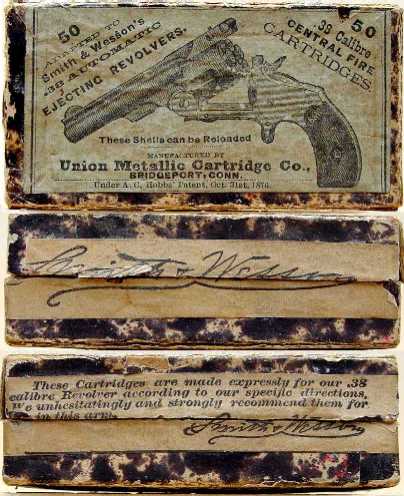 This
first box is quite early, based on its square-corners, which was the style used by UMC
up until about 1883. The S&W 38 Single Action 1st Model (aka Baby
Russian) Revolver pictured on the label was produced for only two years,
from 1876 to1877, after which it was replaced by the 38 Single Action 2nd
Model Revolver. This box would not have been produced very long after 1877,
as Smith & Wesson would have wanted to get the new model revolver on
the label as soon as possible after its introduction. The top label
references Albert C. Hobbs' October 31st, 1876 patent, which covered the
positioning and
securing of the primer anvil in the primer cup. He held an 1871 patent with
Jerome Orcutt for a primer that positioned the anvil, which was a flat round
disk, on its edge in the cup, but the anvils were not securely fastened in
the cups and tended to tip to the side, resulting in misfires. I discussed
this primer on my September
2005 picture page. A patent improvement in 1874 modified the anvil to
have six or eight flat sides, but this apparently did not prove to be a
satisfactory solution. The 1876 patent placed the anvil flat on
its side in the cup, with cutouts around the edge to allow the fire from the primer
ignition to pass by the anvil, and with the sharp edges of the anvil holding
it in place in the cup. This is pretty much how a primer patented earlier by
Oliver Winchester (1874) was constructed, but Hobbs still managed to secure
his patent on this similar design. A label pasted inside the top of this box
reads 'In
reloading these shells, use WESSON PRIMER'. U.M.C marketed the Hobbs primer
as the Wesson primer, and referenced the Hobbs 1876 patent on the labels of
these primers. See my August
2005 picture page for a picture and discussion of a Wesson Primer tin.
Considering that the .38 S&W cartridge was developed for use in the Baby
Russian, and with the signed Smith & Wesson statement on one side
of the side-sealing label and their signature on the other side, I would
assume this ammunition was made especially for them, perhaps to be sold
exclusively by the retailers of their revolvers. The ends of the sealing
label are
marked simply '.38 S.& W.'. This box is empty, but the
cartridges it originally held would have been unheadstamped and of folded
head construction, with a long grooved bullet, as shown with the box below. This
first box is quite early, based on its square-corners, which was the style used by UMC
up until about 1883. The S&W 38 Single Action 1st Model (aka Baby
Russian) Revolver pictured on the label was produced for only two years,
from 1876 to1877, after which it was replaced by the 38 Single Action 2nd
Model Revolver. This box would not have been produced very long after 1877,
as Smith & Wesson would have wanted to get the new model revolver on
the label as soon as possible after its introduction. The top label
references Albert C. Hobbs' October 31st, 1876 patent, which covered the
positioning and
securing of the primer anvil in the primer cup. He held an 1871 patent with
Jerome Orcutt for a primer that positioned the anvil, which was a flat round
disk, on its edge in the cup, but the anvils were not securely fastened in
the cups and tended to tip to the side, resulting in misfires. I discussed
this primer on my September
2005 picture page. A patent improvement in 1874 modified the anvil to
have six or eight flat sides, but this apparently did not prove to be a
satisfactory solution. The 1876 patent placed the anvil flat on
its side in the cup, with cutouts around the edge to allow the fire from the primer
ignition to pass by the anvil, and with the sharp edges of the anvil holding
it in place in the cup. This is pretty much how a primer patented earlier by
Oliver Winchester (1874) was constructed, but Hobbs still managed to secure
his patent on this similar design. A label pasted inside the top of this box
reads 'In
reloading these shells, use WESSON PRIMER'. U.M.C marketed the Hobbs primer
as the Wesson primer, and referenced the Hobbs 1876 patent on the labels of
these primers. See my August
2005 picture page for a picture and discussion of a Wesson Primer tin.
Considering that the .38 S&W cartridge was developed for use in the Baby
Russian, and with the signed Smith & Wesson statement on one side
of the side-sealing label and their signature on the other side, I would
assume this ammunition was made especially for them, perhaps to be sold
exclusively by the retailers of their revolvers. The ends of the sealing
label are
marked simply '.38 S.& W.'. This box is empty, but the
cartridges it originally held would have been unheadstamped and of folded
head construction, with a long grooved bullet, as shown with the box below.
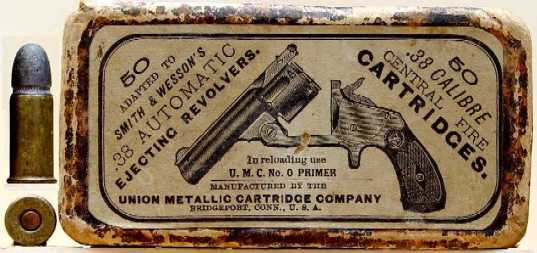 This
next box would have been produced shortly after the box shown above.
It has rounded corners, which were used on UMC boxes beginning in 1883 and
continuing well into the 1900s. The label is laid out similarly to the
one above, except that this one pictures the Smith & Wesson .38 Single
Action 2nd Model revolver, which was produced between 1877 and 1885, and
incorporated an improvement in the ejection mechanism over the earlier
model. At the time this box was made, the recommended primer for reloading
the fired cases was the UMC No 0, as is noted on the front label. Since it
is already addressed on the label, This
next box would have been produced shortly after the box shown above.
It has rounded corners, which were used on UMC boxes beginning in 1883 and
continuing well into the 1900s. The label is laid out similarly to the
one above, except that this one pictures the Smith & Wesson .38 Single
Action 2nd Model revolver, which was produced between 1877 and 1885, and
incorporated an improvement in the ejection mechanism over the earlier
model. At the time this box was made, the recommended primer for reloading
the fired cases was the UMC No 0, as is noted on the front label. Since it
is already addressed on the label,
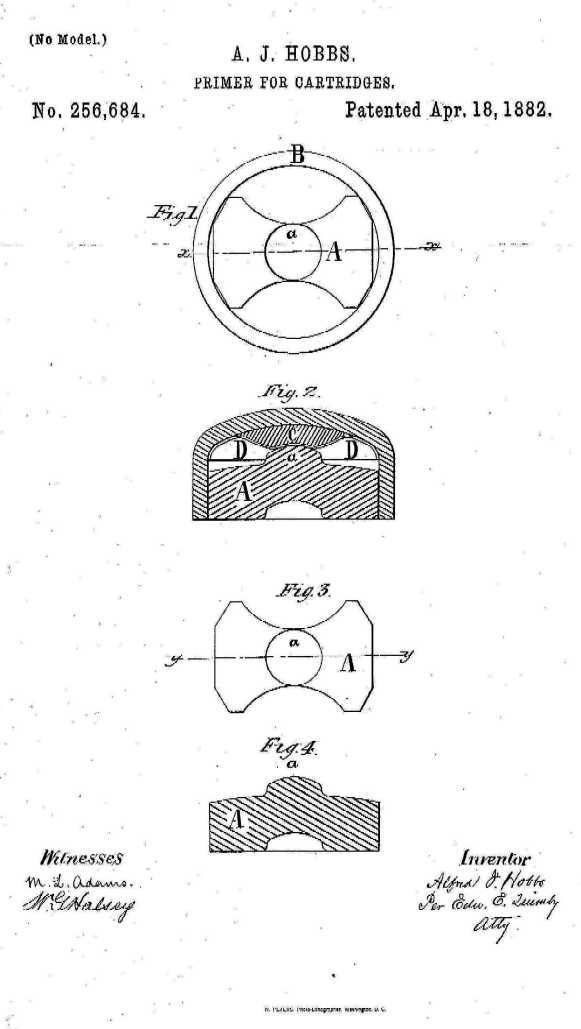 there
was no need to include an inside label regarding the correct primer to use,
so this box has none. On April 18, 1882, A.J. Hobbs, son of A.C., received a
patent for a primer which had an anvil of similar construction to his
father's 1876 patent design, but which had a projection on its face against which the priming
compound was struck to ignite it. The patent was assigned by Hobbs to U.M.C.,
and this anvil design continued to be used, with improvements, by U.M.C. and
Remington Arms for over 100 years. It would have been the anvil used in the
full line of U.M.C. numbered (0, 1, 2, 2 1/2...) primers, although the tins
for these primers only reference A.C. Hobbs' September 14, 1869 patent,
which covered the process of sealing the priming composition to make it
waterproof and avoid contact with the metal surfaces inside the primer. I
have included a larger picture of a few of the cartridges from this box in
the picture below. They have an outside-lubed,
grooved bullet, and a folded head case with no headstamp. It is interesting
to note that this unheadstamped cartridge with the long single grooved
bullet has always been called the .38 Merwin & Hulbert. Obviously, the .38
S&W and the .38 M&H started out as the same cartridge. The M&H revolvers
were manufactured in small numbers from about 1876 until the early 1880s, so
while the .38 Smith & Wesson cartridge evolved with that company's
revolvers, making the transition from outside lubricated bullets to inside
lubricated and from black powder to smokeless, ammunition for the Merwin &
Hulbert revolvers continued to be produced as it originally was designed. As
late as 1916, Winchester was still listing its .38 M&H cartridges which had
this grooved bullet, but these may have been stock on hand that had been
manufactured years earlier. One of the cartridges in this picture has been there
was no need to include an inside label regarding the correct primer to use,
so this box has none. On April 18, 1882, A.J. Hobbs, son of A.C., received a
patent for a primer which had an anvil of similar construction to his
father's 1876 patent design, but which had a projection on its face against which the priming
compound was struck to ignite it. The patent was assigned by Hobbs to U.M.C.,
and this anvil design continued to be used, with improvements, by U.M.C. and
Remington Arms for over 100 years. It would have been the anvil used in the
full line of U.M.C. numbered (0, 1, 2, 2 1/2...) primers, although the tins
for these primers only reference A.C. Hobbs' September 14, 1869 patent,
which covered the process of sealing the priming composition to make it
waterproof and avoid contact with the metal surfaces inside the primer. I
have included a larger picture of a few of the cartridges from this box in
the picture below. They have an outside-lubed,
grooved bullet, and a folded head case with no headstamp. It is interesting
to note that this unheadstamped cartridge with the long single grooved
bullet has always been called the .38 Merwin & Hulbert. Obviously, the .38
S&W and the .38 M&H started out as the same cartridge. The M&H revolvers
were manufactured in small numbers from about 1876 until the early 1880s, so
while the .38 Smith & Wesson cartridge evolved with that company's
revolvers, making the transition from outside lubricated bullets to inside
lubricated and from black powder to smokeless, ammunition for the Merwin &
Hulbert revolvers continued to be produced as it originally was designed. As
late as 1916, Winchester was still listing its .38 M&H cartridges which had
this grooved bullet, but these may have been stock on hand that had been
manufactured years earlier. One of the cartridges in this picture has been
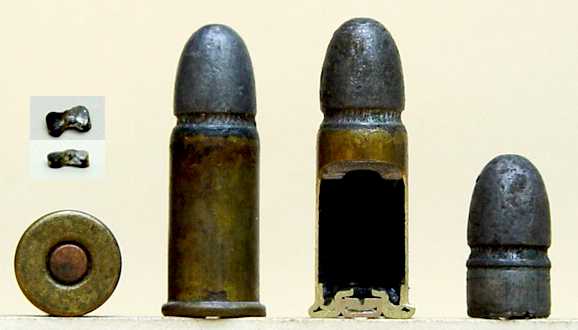 sectioned
to show the construction of the head, which includes a reinforcing piece
shaped like a donut that slips down around the primer pocket and against the
inside of the head to prevent the case from rupturing at the rim when it is
fired. It is difficult to see the primer anvil very well in the sectioned
head, so I have included a couple of enlarged views of the anvil; it
is a roughly-made bow tie-shaped piece of brass which appears to have been
tinned, giving it a silver color. The projection on which the patent was
based is understated and is not so apparent as it is in the patent drawing. I
have to assume this primer is the UMC No 0 as noted on the box,
indicating that it was probably made in 1882 or later. As the round cornered
boxes were introduced by UMC in 1883, and the Model 2 revolver was not made
after 1885, then this box was most likely made during the three year period
from 1883 through 1885 or shortly thereafter. The side labels are marked in
the same manner as the box above. sectioned
to show the construction of the head, which includes a reinforcing piece
shaped like a donut that slips down around the primer pocket and against the
inside of the head to prevent the case from rupturing at the rim when it is
fired. It is difficult to see the primer anvil very well in the sectioned
head, so I have included a couple of enlarged views of the anvil; it
is a roughly-made bow tie-shaped piece of brass which appears to have been
tinned, giving it a silver color. The projection on which the patent was
based is understated and is not so apparent as it is in the patent drawing. I
have to assume this primer is the UMC No 0 as noted on the box,
indicating that it was probably made in 1882 or later. As the round cornered
boxes were introduced by UMC in 1883, and the Model 2 revolver was not made
after 1885, then this box was most likely made during the three year period
from 1883 through 1885 or shortly thereafter. The side labels are marked in
the same manner as the box above.
I will continue with pictures of more in the UMC series of .38 S&W boxes next month.
.
I give up! What is this one?????
Regardless of how good at identifying unheadstamped cartridges you tell yourself you are, you will occasionally encounter one that seems to
be intent on proving your self assessment incorrect. I always have three or
four in my collection at any one time that defy my efforts. Eventually, I'll
throw in the towel and admit that I'm stumped, and that's when I appeal to
the other collectors out there to lend a hand. Someone typically comes
through for me, often serving me a dose of humility with such statements as
'You should have known this one' or 'Even a beginner should be able to identify this'.
Such will probably
be the case with this one, which I have been trying to identify for another
collector to no avail. The dimensions are:
Bullet at case mouth
.428"
Mouth .465"
Base .485"
Rim .540"
Case Length .741"
Overall length 1.252"
My initial gut feeling was that this was just another variation of the British
.450 revolver cartridge, but the tapered .741" case and that long flat nose
bullet are making it hard to convince
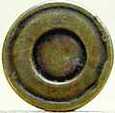 myself that it is. The
case is unusual, having the general look of a folded head type with a raised
ring. However, it appears that the head is a separate piece that has been
fit into the rim, and the rim then folded over it to hold it in place and
form a seal. The folded edge is uneven, as can clearly be seen in this
enlarged picture, and results in a slightly off-center primer. So,
knowledgeable readers, what is it? myself that it is. The
case is unusual, having the general look of a folded head type with a raised
ring. However, it appears that the head is a separate piece that has been
fit into the rim, and the rim then folded over it to hold it in place and
form a seal. The folded edge is uneven, as can clearly be seen in this
enlarged picture, and results in a slightly off-center primer. So,
knowledgeable readers, what is it?
.
.
A great Frankford Arsenal .50-70
box.......
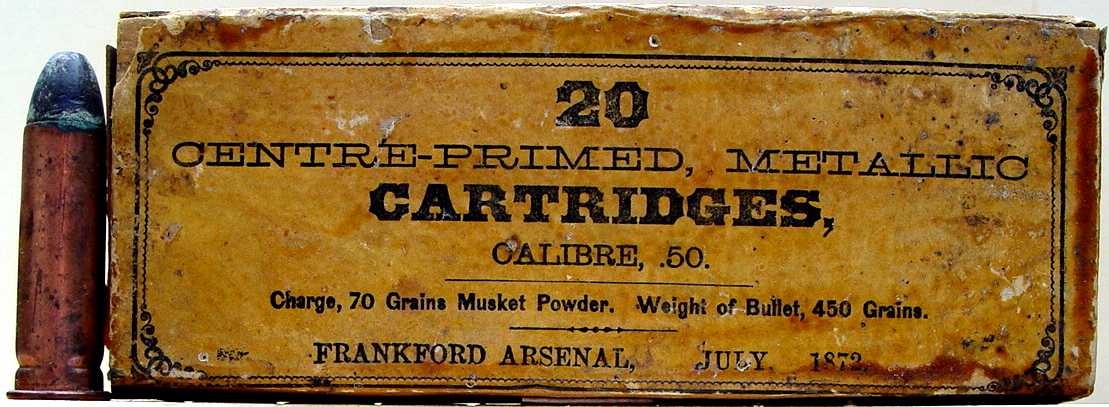
.
.
.
.
.
Here's a really nice box of .50-70 Government cartridges made at the
Frankford Arsenal in July of 1872, around the time Army trials got underway
for the purpose of finding a replacement for the .50 Springfield rifle. In
spite of a number of good quality repeating rifles that were included in the
trials, the result was the selection in the Spring of 1873 of the .45-70
Springfield Trapdoor rifle, which was little more than an updated, smaller caliber
version of the rifle they already had. The cartridges in this box are inside
primed, utilizing the Benet primer, which continued to be used at the
Frankford Arsenal as the standard for .45-70 cartridges until August of
1882.
.
.
.
|

 This
first box is quite early, based on its square-corners, which was the style used by UMC
up until about 1883. The S&W 38 Single Action 1st Model (aka Baby
Russian) Revolver pictured on the label was produced for only two years,
from 1876 to1877, after which it was replaced by the 38 Single Action 2nd
Model Revolver. This box would not have been produced very long after 1877,
as Smith & Wesson would have wanted to get the new model revolver on
the label as soon as possible after its introduction. The top label
references Albert C. Hobbs' October 31st, 1876 patent, which covered the
positioning and
securing of the primer anvil in the primer cup. He held an 1871 patent with
Jerome Orcutt for a primer that positioned the anvil, which was a flat round
disk, on its edge in the cup, but the anvils were not securely fastened in
the cups and tended to tip to the side, resulting in misfires. I discussed
this primer on my
This
first box is quite early, based on its square-corners, which was the style used by UMC
up until about 1883. The S&W 38 Single Action 1st Model (aka Baby
Russian) Revolver pictured on the label was produced for only two years,
from 1876 to1877, after which it was replaced by the 38 Single Action 2nd
Model Revolver. This box would not have been produced very long after 1877,
as Smith & Wesson would have wanted to get the new model revolver on
the label as soon as possible after its introduction. The top label
references Albert C. Hobbs' October 31st, 1876 patent, which covered the
positioning and
securing of the primer anvil in the primer cup. He held an 1871 patent with
Jerome Orcutt for a primer that positioned the anvil, which was a flat round
disk, on its edge in the cup, but the anvils were not securely fastened in
the cups and tended to tip to the side, resulting in misfires. I discussed
this primer on my  This
next box would have been produced shortly after the box shown above.
It has rounded corners, which were used on UMC boxes beginning in 1883 and
continuing well into the 1900s. The label is laid out similarly to the
one above, except that this one pictures the Smith & Wesson .38 Single
Action 2nd Model revolver, which was produced between 1877 and 1885, and
incorporated an improvement in the ejection mechanism over the earlier
model. At the time this box was made, the recommended primer for reloading
the fired cases was the UMC No 0, as is noted on the front label. Since it
is already addressed on the label,
This
next box would have been produced shortly after the box shown above.
It has rounded corners, which were used on UMC boxes beginning in 1883 and
continuing well into the 1900s. The label is laid out similarly to the
one above, except that this one pictures the Smith & Wesson .38 Single
Action 2nd Model revolver, which was produced between 1877 and 1885, and
incorporated an improvement in the ejection mechanism over the earlier
model. At the time this box was made, the recommended primer for reloading
the fired cases was the UMC No 0, as is noted on the front label. Since it
is already addressed on the label,
 there
was no need to include an inside label regarding the correct primer to use,
so this box has none. On April 18, 1882, A.J. Hobbs, son of A.C., received a
patent for a primer which had an anvil of similar construction to his
father's 1876 patent design, but which had a projection on its face against which the priming
compound was struck to ignite it. The patent was assigned by Hobbs to U.M.C.,
and this anvil design continued to be used, with improvements, by U.M.C. and
Remington Arms for over 100 years. It would have been the anvil used in the
full line of U.M.C. numbered (0, 1, 2, 2 1/2...) primers, although the tins
for these primers only reference A.C. Hobbs' September 14, 1869 patent,
which covered the process of sealing the priming composition to make it
waterproof and avoid contact with the metal surfaces inside the primer. I
have included a larger picture of a few of the cartridges from this box in
the picture below. They have an outside-lubed,
grooved bullet, and a folded head case with no headstamp. It is interesting
to note that this unheadstamped cartridge with the long single grooved
bullet has always been called the .38 Merwin & Hulbert. Obviously, the .38
S&W and the .38 M&H started out as the same cartridge. The M&H revolvers
were manufactured in small numbers from about 1876 until the early 1880s, so
while the .38 Smith & Wesson cartridge evolved with that company's
revolvers, making the transition from outside lubricated bullets to inside
lubricated and from black powder to smokeless, ammunition for the Merwin &
Hulbert revolvers continued to be produced as it originally was designed. As
late as 1916, Winchester was still listing its .38 M&H cartridges which had
this grooved bullet, but these may have been stock on hand that had been
manufactured years earlier. One of the cartridges in this picture has been
there
was no need to include an inside label regarding the correct primer to use,
so this box has none. On April 18, 1882, A.J. Hobbs, son of A.C., received a
patent for a primer which had an anvil of similar construction to his
father's 1876 patent design, but which had a projection on its face against which the priming
compound was struck to ignite it. The patent was assigned by Hobbs to U.M.C.,
and this anvil design continued to be used, with improvements, by U.M.C. and
Remington Arms for over 100 years. It would have been the anvil used in the
full line of U.M.C. numbered (0, 1, 2, 2 1/2...) primers, although the tins
for these primers only reference A.C. Hobbs' September 14, 1869 patent,
which covered the process of sealing the priming composition to make it
waterproof and avoid contact with the metal surfaces inside the primer. I
have included a larger picture of a few of the cartridges from this box in
the picture below. They have an outside-lubed,
grooved bullet, and a folded head case with no headstamp. It is interesting
to note that this unheadstamped cartridge with the long single grooved
bullet has always been called the .38 Merwin & Hulbert. Obviously, the .38
S&W and the .38 M&H started out as the same cartridge. The M&H revolvers
were manufactured in small numbers from about 1876 until the early 1880s, so
while the .38 Smith & Wesson cartridge evolved with that company's
revolvers, making the transition from outside lubricated bullets to inside
lubricated and from black powder to smokeless, ammunition for the Merwin &
Hulbert revolvers continued to be produced as it originally was designed. As
late as 1916, Winchester was still listing its .38 M&H cartridges which had
this grooved bullet, but these may have been stock on hand that had been
manufactured years earlier. One of the cartridges in this picture has been
 sectioned
to show the construction of the head, which includes a reinforcing piece
shaped like a donut that slips down around the primer pocket and against the
inside of the head to prevent the case from rupturing at the rim when it is
fired. It is difficult to see the primer anvil very well in the sectioned
head, so I have included a couple of enlarged views of the anvil; it
is a roughly-made bow tie-shaped piece of brass which appears to have been
tinned, giving it a silver color. The projection on which the patent was
based is understated and is not so apparent as it is in the patent drawing. I
have to assume this primer is the UMC No 0 as noted on the box,
indicating that it was probably made in 1882 or later. As the round cornered
boxes were introduced by UMC in 1883, and the Model 2 revolver was not made
after 1885, then this box was most likely made during the three year period
from 1883 through 1885 or shortly thereafter. The side labels are marked in
the same manner as the box above.
sectioned
to show the construction of the head, which includes a reinforcing piece
shaped like a donut that slips down around the primer pocket and against the
inside of the head to prevent the case from rupturing at the rim when it is
fired. It is difficult to see the primer anvil very well in the sectioned
head, so I have included a couple of enlarged views of the anvil; it
is a roughly-made bow tie-shaped piece of brass which appears to have been
tinned, giving it a silver color. The projection on which the patent was
based is understated and is not so apparent as it is in the patent drawing. I
have to assume this primer is the UMC No 0 as noted on the box,
indicating that it was probably made in 1882 or later. As the round cornered
boxes were introduced by UMC in 1883, and the Model 2 revolver was not made
after 1885, then this box was most likely made during the three year period
from 1883 through 1885 or shortly thereafter. The side labels are marked in
the same manner as the box above.
 myself that it is. The
case is unusual, having the general look of a folded head type with a raised
ring. However, it appears that the head is a separate piece that has been
fit into the rim, and the rim then folded over it to hold it in place and
form a seal. The folded edge is uneven, as can clearly be seen in this
enlarged picture, and results in a slightly off-center primer. So,
knowledgeable readers, what is it?
myself that it is. The
case is unusual, having the general look of a folded head type with a raised
ring. However, it appears that the head is a separate piece that has been
fit into the rim, and the rim then folded over it to hold it in place and
form a seal. The folded edge is uneven, as can clearly be seen in this
enlarged picture, and results in a slightly off-center primer. So,
knowledgeable readers, what is it?